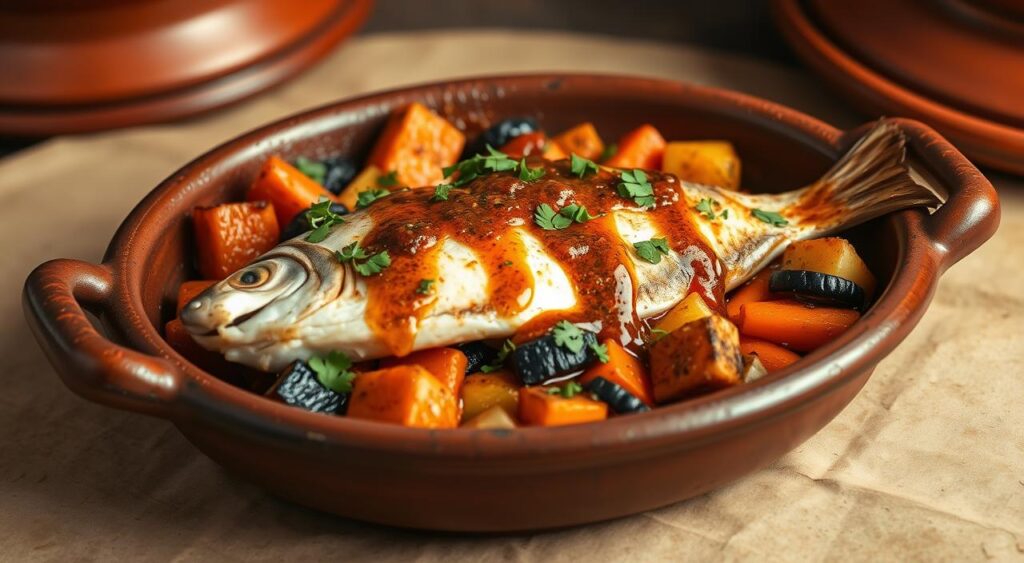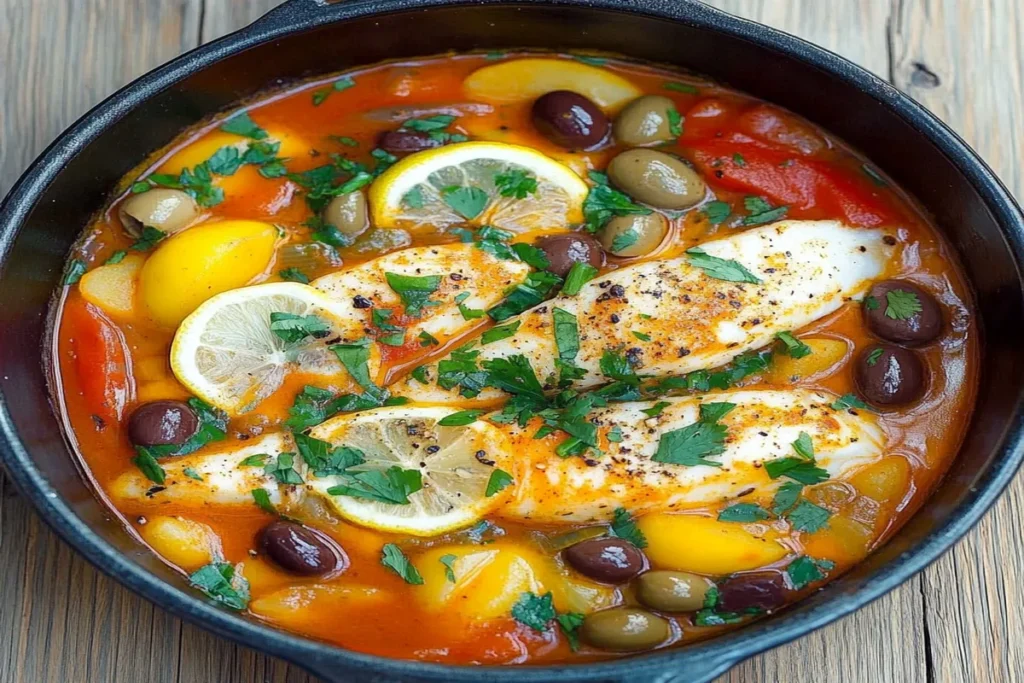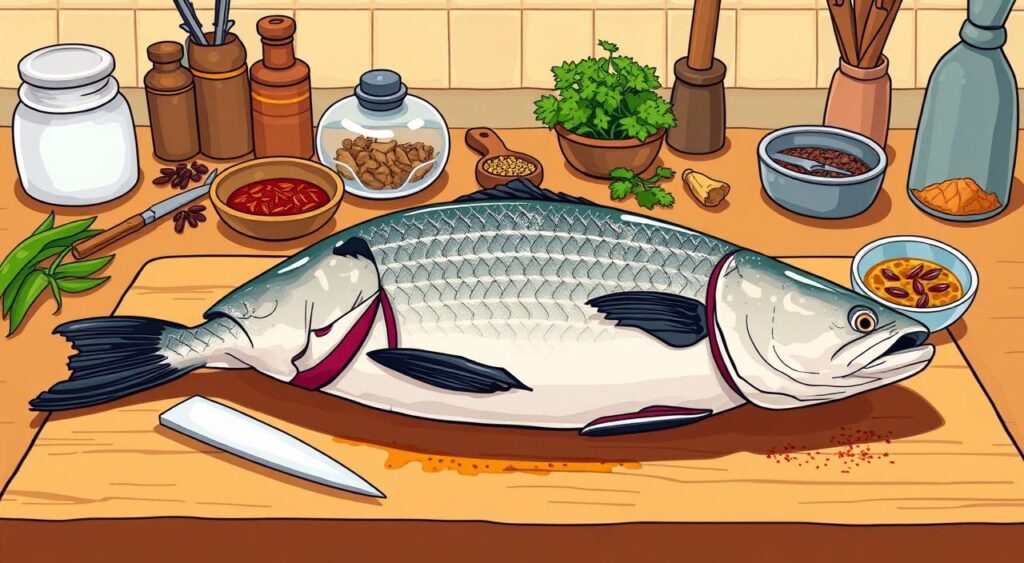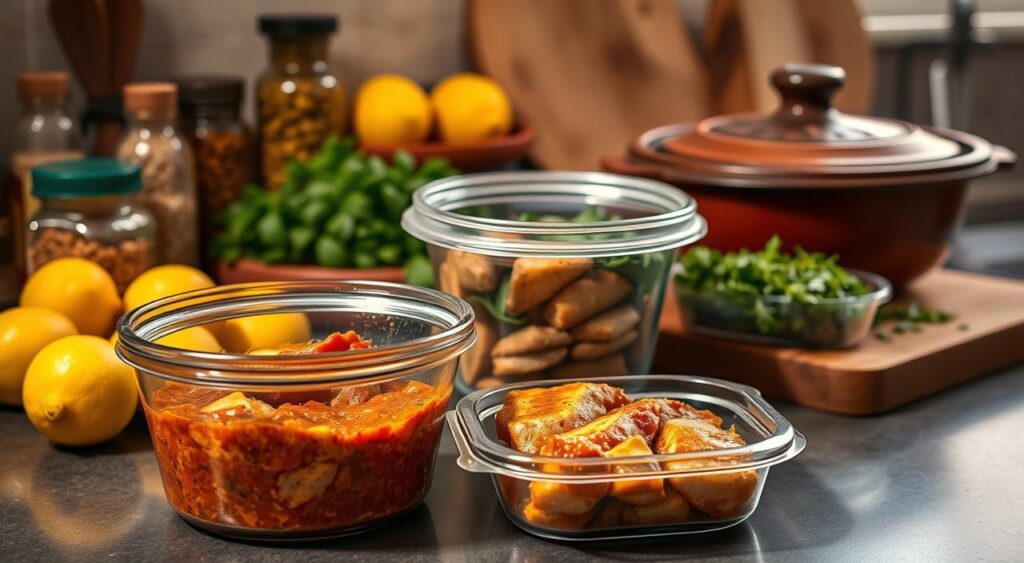Moroccan fish tagine is a traditional North African dish, and it became a global favorite. Explore the blend of flaky fish, zesty chermoula sauce, and coastal flavors with ancient cooking techniques. Unveil the symphony of citrus, herbs, and spices in this authentic recipe.
Moroccan fish tagine is a dish that has captured the hearts of seafood lovers worldwide. This traditional North African dish combines flaky fish with the zesty kick of chermoula sauce, offering a unique blend of coastal flavors and ancient cooking techniques. It’s a recipe that transforms simple ingredients into a symphony of citrus, herbs, and spices, making Moroccan fish tagine a must-try dish.
This article unlocks the secrets behind Moroccan fish tagine. It’s a dish where flaky fish meets the zesty kick of chermoula sauce. Find out how an authentic Moroccan recipe combines coastal flavors with ancient cooking techniques. It turns everyday ingredients into a symphony of citrus, herbs, and spices

Key Takeaways
- Learn how North African cuisine uses chermoula to balance bold flavors
- Master the art of layering fish and vegetables in a clay tagine pot
- Understand why chermoula sauce is key to preventing overcooking delicate fish
- Discover regional adaptations from Rabat to Casablanca
- Get tips for pairing with traditional bread and salads
Introduction to Moroccan Cuisine and Tagine Cooking
Moroccan cuisine is a mix of flavors from Africa, the Mediterranean, and the Middle East. Tagine cooking is a key part of its identity. The tagine pot, with its unique cone-shaped lid, is more than a tool—it’s a symbol of Morocco’s rich heritage.
This earthenware vessel has been used for centuries. It shapes how ingredients like fish, vegetables, and spices come together in slow-cooked harmony.
The Cultural Significance of Tagine in Morocco
Sharing a traditional tagine is a communal act. Families and guests gather around the pot, showing the warmth of Moroccan hospitality. The dish’s slow simmering mirrors the patience and care central to Moroccan traditions.
Food is a celebration of togetherness in Morocco.
Traditional Cooking Methods and the Tagine Pot
Moroccan chefs use the tagine pot to create tender, flavorful dishes. The pot’s design traps steam, circulating it back into the ingredients for even cooking. Key steps include:
- Layering ingredients like fish, vegetables, and spices
- Cooking over low heat to preserve moisture and flavors
- Using the cone lid to redistribute juices naturally
How Tagine Dishes Represent Moroccan Hospitality
In Moroccan culture, a well-prepared traditional tagine embodies generosity. Meals are never rushed hosts take time to ensure every guest feels welcomed. This spirit of sharing is why tagine dishes are staples at weddings, festivals, and everyday meals alike.
What is Chermoula Sauce and Why It’s Essential
At the heart of Moroccan fish tagine is chermoula marinade. It’s a bold mix of flavors that turns simple ingredients into a masterpiece. This fresh herb marinade combines cilantro, parsley, and garlic with tangy lemon juice and fragrant Moroccan spices. It’s all mixed with olive oil.
Its purpose is to add bright, herbaceous notes to fish while keeping it fresh. This tradition comes from coastal fishing communities.
The magic begins with fish marinade techniques. Acidic citrus and spices like cumin and paprika tenderize the fish. This creates a balance of zesty, smoky, and earthy flavors.
Unlike store-bought versions, authentic chermoula is best when made fresh. It ensures vibrant, unprocessed taste. Key ingredients include:
- Cilantro and parsley for freshness
- Garlic and ginger for depth
- Cumin, coriander, and paprika for warmth
- Extra virgin olive oil as the base
Across North Africa, variations of chermoula emerge. Some recipes add preserved lemons, others omit garlic. Yet, the core remains the same.
Chermoula marinade acts as both marinade and finishing sauce. It elevates seafood and ties the dish to its cultural roots. Whether drizzled over grilled sardines or layered in a tagine, it’s the signature touch that defines this dish.
The History Behind Moroccan Fish Tagine with Chermoula and Vegetables
Explore the Moroccan food history of a dish deeply rooted in the country’s fishing past. From the ancient Barberes to Arab traders, coastal Moroccan cuisine was shaped by the Atlantic and Mediterranean. This mix of cultures transformed simple fish into famous North African fish dishes.

Early dishes used Mediterranean seafood and salt to keep fish fresh. Spices like cumin and coriander added flavor. These methods evolved into the traditional Moroccan food we enjoy today.
Origins of the Dish in Coastal Morocco
In places like Essaouira, fishermen combined fresh fish with preserved lemons and olives. The tagine pot was key for slow cooking, blending flavors into every bite. Trade brought in garlic and parsley, enhancing coastal dishes.
How the Recipe Has Evolved Over Time
With trade expanding, spices like paprika and saffron were added to chermoula marinades. Recipes moved from practical to celebratory. Today, chefs mix old techniques with new ideas, keeping the essence of tradition.
Regional Variations Throughout North Africa
- Northern areas use milder herbs like cilantro.
- Southern versions add chili peppers for heat.
- In Algeria and Tunisia, tomato-based sauces appear, showing shared culinary ties.
Each region’s version reflects local tastes and history. This shows the dish’s flexibility while staying true to its roots.
Essential Ingredients for Authentic Moroccan Fish Tagine
To make a real Moroccan fish tagine, you need the right fish tagine ingredients. This dish needs fresh, top-quality stuff to get the flavors and textures right. Use traditional or local items that respect the dish’s heritage but also fit what’s available.
Choosing the Perfect Fish
For a Mediterranean fish tagine, go for firm white fish like cod, halibut, or sea bass. These keep their shape while cooking slowly. If these aren’t around, striped bass or tilapia from the US works too. Make sure the fish is sustainably caught, fresh, or frozen for the best taste.
Herbs and Moroccan Spices for Chermoula
Chermoula’s lively taste comes from fresh herbs and spices. You’ll need:
- Cilantro and parsley (crushed for freshness)
- Garlic and preserved lemons for tang
- Cumin, paprika, and coriander for depth
Choose fresh herbs over dried for the best smell. Play with spice amounts to taste, but don’t mask the fish’s natural sweetness.
Traditional Tagine Vegetables and Substitutions
Classic authentic Moroccan ingredients include:
| Vegetable | Role | Substitute |
|---|---|---|
| Potatoes | Create a flavorful base layer | Carrots or parsnips |
| Bell peppers | Add color and crunch | Zucchini |
| Tomatoes | Moisture and acidity | Canned diced tomatoes |
Preserved lemons give a unique salty flavor; use lemon zest if you can’t find them. Arrange vegetables to cook evenly.
Step-by-Step Guide to Making Chermoula Sauce
Learning to make chermoula recipe begins with the basics of spice blend preparation. Start by toasting cumin and coriander seeds in a dry pan until they smell great. Then, grind them into a fine powder to use as the base of your Moroccan marinade.
- Chop fresh cilantro, parsley, and green onions. Mix different herbs to balance out the flavors.
- In a bowl, mix toasted spices with minced garlic and preserved lemon. Slowly add olive oil and lemon juice while stirring.
- Use a food processor to blend the ingredients until they’re slightly chunky. This texture is perfect for a herb sauce recipe on fish.
Pro tip: Add lemon juice last. This helps prevent the herbs from turning brown too quickly, keeping the sauce bright. Taste and adjust the seasoning with salt or add more heat from harissa or chili flakes. For a smoother sauce, blend longer; for a chunkier texture, stop sooner.
- Keep it in an airtight container in the fridge. The flavors will meld together overnight.
- Use it within 5 days for the best taste.
- Try swapping mint for some cilantro for a coastal twist in your homemade chermoula.
A well-made chermoula should be bright yet complex. It should have herbal notes upfront and smoky spices in the background. This sauce is more than just a topping—it’s the heart of your tagine.
Preparing Your Fish for the Perfect Tagine
Mastering fish preparation is key to unlocking the rich flavors of Moroccan cuisine. Whether buying from a market or supermarket, fresh fish selection sets the foundation for a memorable dish. Let’s break down each step to ensure your fish shines in every bite.

Selecting the Freshest Fish
Look for seafood preparation essentials: clear eyes, shiny scales, and a mild ocean scent. Firm flesh that springs back when touched signals freshness. If fresh options are limited, opt for high-quality frozen fish—thaw it completely and pat dry before use.
- Check gill color: bright red means freshness.
- Avoid fish with soft flesh or strong odors.
- Choose white-fleshed fish like cod or hake for even cooking.
Cleaning and Prep Techniques
Proper fish cleaning techniques keep the dish light and clean. Scale the fish under cold water, then gut and rinse thoroughly. Leave skin on for flavor retention—skin adds texture when cooked in the tagine pot. Trim any dark flesh, which can taste bitter.
Marinating for Maximum Flavor
Marinate the fish in chermoula for 30 minutes to 2 hours. Over-marinating can toughen the flesh. For even absorption, coat all sides and refrigerate to prevent spoilage. Use airtight containers and avoid metal bowls, as acid in herbs reacts with metal.
Following these steps ensures your fish preparation aligns with traditional methods, balancing tradition and safety.
Vegetable Preparation and Layering Techniques
Mastering vegetable layering is key to balancing flavors in your Moroccan fish tagine. Start by selecting firm, seasonal vegetables like potatoes, carrots, zucchini, and eggplant. For Moroccan vegetable preparation, slice potatoes thinly to form a crispy base layer. Dice carrots and zucchini into even cubes to ensure even cooking vegetables in tagine. Eggplant needs a quick salt bath to draw out bitterness before adding to the pot.
Traditional tagine vegetables are layered in a specific sequence. Begin with potatoes at the bottom to absorb the pot’s heat. Next, arrange carrots and tomatoes (seeded to avoid excess moisture). Top with zucchini and eggplant, saving delicate onions for the upper layers. This traditional tagine assembly ensures each vegetable cooks to perfection without over softening. Add preserved lemons and green olives between layers for bursts of tangy flavor.
- Peel and slice potatoes ¼-inch thick
- Season vegetables with cumin and paprika before layering
- Reserve leafy herbs like parsley for the final layer
“The bottom layer must never be overcrowded—space allows juices to circulate,” says Chef Amina El Fassi, a Marrakech-based culinary instructor.
When cooking vegetables in tagine, time is critical. Dense veggies like carrots need 15-20 minutes in the pot before adding fish. Adjust quantities seasonally—swap out of-season veggies with bell peppers or artichokes while keeping the layering logic intact. Proper technique ensures every bite delivers the dish’s signature harmony.
Complete Recipe: Moroccan Fish Tagine with Chermoula and Vegetables
Bring the flavors of coastal Morocco to your kitchen with this complete fish tagine guide. Whether using a traditional clay pot or a Dutch oven, follow these steps for a dish that balances tangy chermoula fish recipe brilliance with tender vegetables.
Ingredients List
- Chermoula Sauce: 1/4 cup olive oil, 3 tbsp lemon juice, 1/2 cup chopped cilantro, 2 minced garlic cloves, 1 tsp paprika, 1 tsp cumin, salt & pepper
- Fish: 4 firm white fish fillets (1 lb. total), like cod or haddock)
- Vegetables: 1 diced onion, 2 sliced potatoes, 1 bell pepper, 1 zucchini (all prepped into bite-sized pieces)
- Garnishes: Fresh cilantro, lemon wedges, harissa paste
Cooking Instructions
- Prepare chermoula fish recipe by mixing all sauce ingredients. Marinate fish in half the sauce for 15 minutes.
- In a tagine pot, sauté onions until translucent. Layer potatoes, bell pepper, and zucchini in the pot.
- Place marinated fish on top. Drizzle remaining chermoula over vegetables. Cover and cook at tagine cooking temperature of 325°F for 25-30 minutes.
- Let sit 5 minutes before serving with garnishes. Total Moroccan cooking times including prep: ~1 hour.
Timing and Temperature Guidelines
Keep the pot covered during the Moroccan cooking times to trap steam. Adjust tagine cooking temperature if fish is thicker—add 5 minutes per extra inch of thickness. The fish is done when flakes easily with a fork. Serve immediately for best texture.
No Tagine Pot? Alternative Cooking Methods
Don’t have a traditional tagine pot? No problem! These tagine alternatives let you recreate the dish’s rich flavors without the original equipment. Choose from a Dutch oven tagine, slow cooker Moroccan fish setup, or an oven-baked tagine. Follow these tips to preserve the dish’s essence:
| Method | Best For | Key Tips |
|---|---|---|
| Dutch Oven/Heavy Skillet | Even heat and moisture | Use lid, reduce liquid by 25%, stir gently |
| Slow Cooker | Hands-off cooking | Layer veggies first, cook low 2–3 hours |
| Oven-Baked | Crispy texture | 350°F, uncover last 10 mins |
Using a Dutch Oven or Heavy Skillet
A Dutch oven tagine mimics the original pot’s slow cooking. Use a lid to trap steam and reduce liquid by 25% to avoid sogginess. Cook on medium-low heat:
- Cover tightly to maintain moisture
- Reduce liquid by 25% for proper consistency
- Stir gently to prevent fish from breaking apart
Slow Cooker Adaptation
Cook slow cooker Moroccan fish by layering ingredients strategically. Start with veggies, add fish on top, and set to low heat:
- Layer veggies first, then fish on top
- Cook on low for 2–3 hours total
- Check fish for flakiness before serving
Oven-Baked Version
Bake at 350°F for a crisp finish. Start covered, then uncover the last 10 minutes:
- Preheat oven to 350°F
- Cover with foil initially, then remove for browning
- Flip fish halfway for even cooking
These alternative cooking methods make the dish accessible to all kitchens. Experiment to find your favorite technique!
Health Benefits of Moroccan Fish Tagine
Moroccan fish tagine is more than just a tasty dish. It’s a healthy fish recipe full of good stuff. It follows the Mediterranean diet and is a key part of healthy Moroccan cooking. It’s all about balance, with protein, healthy fats, and vitamins. Here’s why it’s great for your meals.
- Lean protein powerhouse: White fish as cod or hake offer protein without too much fat.
- Omega-3 boosts: Fatty fish in this dish give you important fatty acids for heart and brain health.
- Antioxidant-rich herbs: Chermoula’s cilantro, garlic, and cumin have anti-inflammatory compounds.
- Vegetable harmony: Zucchini, tomatoes, and onions add fiber and vitamins without sugar.
“The Mediterranean diet reduces chronic disease risk by focusing on whole foods and healthy fats.” — Nutritional Research Journal
Cooking in a tagine pot keeps nutrients in with gentle heat, no frying needed. This healthy fish recipe is gluten-free and can be vegan (use tofu) or low-sodium. It’s perfect for heart health or just trying new foods. It’s good for your body and soul.
Perfect Side Dishes and Accompaniments
No meal is complete without the right Moroccan side dishes to balance flavors and textures. Start with Moroccan bread like khobz—a round, slightly chewy flatbread perfect for sopping up tagine sauce. If you can’t find khobz, store-bought pita or a simple dough recipe at home works well.
Traditional Moroccan Bread Options
Pair your fish tagine with Moroccan bread for a hands-on eating experience. Khobz’s neutral taste complements bold chermoula flavors. For homemade versions, mix flour, yeast, and water for a rustic loaf that’s baked until crisp on the outside and soft within.
Complementary Salads and Appetizers
Bright, fresh traditional Moroccan salads add a refreshing contrast. Try zaalouk (smoky eggplant with tomatoes) or a zesty carrot salad tossed with cumin and lemon. A simple cucumber-tomato salad with parsley and olive oil offers light acidity. Starters like marinated olives or spiced nuts make great tagine accompaniments to serve before the main course.
Beverage Pairings
A glass of sweet mint tea is iconic for Moroccan meal pairing. For wine, opt for crisp whites like Vermentino or dry rosés to highlight the fish’s delicate flavor. Citrus juices or herbal infusions also work well.
This spread ensures every bite—from bread to beverage—honors Morocco’s culinary traditions while adapting to modern kitchens.
Storing and Reheating Leftover Tagine
Enjoy your leftover fish tagine safely with proper storing Moroccan food techniques. Let leftovers cool completely before transferring to airtight containers. Keep refrigerated for up to 2 days or freeze for longer storage. For tagine meal prep, divide portions ahead of time to save time during the week.

“Reheating fish properly ensures texture stays tender. Avoid overcooking!”
- Reheat small portions on the stovetop in a saucepan over low heat.
- Microwave in 30-second bursts to retain moisture, stirring between intervals.
- Add a splash of broth or water to prevent drying.
Preserve flavors by adding fresh cilantro or lemon juice when reheating. For preserving tagine flavors, freeze components separately—like fish and sauce—to maintain quality. Leftover fish tagine works well in grain bowls or as a base for fish soup. Always check internal temperatures reach 165°F (74°C) before serving.
Meal prep tip: Marinate fresh fish portions separately for later use. Store chermoula in sealed jars for up to a week. Adjust seasoning when reheating for optimal taste.
Common Mistakes to Avoid When Making Fish Tagine
Mastering Moroccan fish tagine means knowing what to avoid. These tagine mistakes are common but can be fixed easily. Let’s look at the top issues and how to solve them.
Overcooking the Fish
Cooking fish too long makes it dry and crumbly. Here are some fish cooking tips:
- Check fish after 10 minutes—flakes easily with a fork.
- Use a meat thermometer; aim for 145°F (63°C).
- Cover the pot less once fish is nearly done.
Spice Balance Errors
Balancing Moroccan spices is crucial. Too much cumin or paprika can overwhelm the dish. Taste the chermoula before adding it to the fish:
- Start mild, add spices gradually.
- Fix overly spicy sauces with lemon juice or yogurt.
- Adjust bitterness by adding a pinch of sugar.
Vegetable Layering Problems
Tagine troubleshooting often deals with veggies. Place dense carrots or potatoes below delicate zucchini or tomatoes. Layer like this:
- Bottom layer: Onions and root vegetables.
- Middle layer: Tomatoes and mushrooms.
- Top layer: Fish and quick-cooking herbs.
“Patience and small adjustments make all the difference,” says Chef Laila Benbrahim of Marrakech’s La Maison Arabe. “Trust your senses—smell, sight, and taste.”
Remember, mistakes are part of the learning process. But with these steps, you’ll get delicious results every time.
Conclusion
A homemade fish tagine is a celebration of traditional Moroccan cooking. It combines fresh herbs and spices for an authentic North African dish. Each step, from marinating to layering, honors centuries of flavor.
This dish invites you to explore global cuisine with simple, vibrant ingredients. Sharing it with family or friends shows the warmth of Moroccan hospitality. Start with the basics of the chermoula fish recipe, then try new spice blends or sides.
Whether served with bread or paired with mint tea, this meal offers endless possibilities. Let it inspire your next kitchen adventure—a testament to the joy of recreating authentic dishes at home.
FAQ
What types of fish are best for making Moroccan fish tagine?
For Moroccan fish tagine, use firm white fish like cod, halibut, or sea bass. These fish stay firm during cooking. In the U.S., tilapia or mahi-mahi are good substitutes.
Can I make chermoula sauce ahead of time?
Yes, you can! Chermoula sauce can be made ahead and kept in the fridge for up to a week. Its flavors get better with time, making it a great choice for ahead-of-time prep.
What vegetables should I use for the tagine?
Use potatoes, bell peppers, tomatoes, and preserved lemons for a traditional Moroccan fish tagine. You can add seasonal veggies too, but make sure they cook evenly.
How can I adapt this recipe if I don’t have a tagine pot?
No tagine pot? No problem! Use a Dutch oven, heavy skillet, or slow cooker instead. Adjust cooking times slightly, but you’ll still get great results.
Is Moroccan fish tagine a healthy dish?
Yes! It’s full of lean protein, healthy fats from olive oil, and veggies. It’s a nutritious choice that fits the Mediterranean diet well.
How do I know when my fish is perfectly cooked?
The fish should be firm but still moist. It should flake easily with a fork but still be slightly translucent in the middle. Watch the cooking time to avoid overcooking.
What is the best way to store leftover fish tagine?
Cool leftover fish tagine quickly and store it in an airtight container in the fridge for 2-3 days. It freezes well too, keeping the taste fresh.
Can I use dried herbs instead of fresh for chermoula?
You can use dried herbs, but fresh cilantro and parsley give a brighter flavor and better texture. Fresh ingredients are essential for the authentic taste of chermoula sauce.

